The 5 Most Common Soccer Injuries and How to Prevent Them
A guide to getting and staying healthy on the pitch.

Soccer is an exhilarating sport, known for its fast pace, thrilling goals, and incredible athleticism.
However, like all physical activities, it comes with its risks. Injuries are a part of the game, and
understanding the most common ones can help you take the necessary steps to prevent them. In
this blog, we'll break down the five most common soccer injuries and share tips on how to stay
injury-free.
1. Ankle Sprains: A Common Setback in Soccer
Ankle sprains are one of the most frequent injuries seen in soccer. They occur when a player
twists or rolls their ankle during a tackle, a quick pivot, or while making a sharp turn. The
ligaments in the ankle stretch beyond their normal range, causing pain, swelling, and sometimes
bruising.
How to Prevent It:
- Strengthen your ankles: Perform exercises like Single leg balance and strengthening, and resistance band work at the ankle to improve ankle stability.
- Proper footwear: Wear cleats that fit well and provide adequate support for your foot and ankle.
- Warm up properly: Focus on stretching and mobility exercises for the lower body before playing.
2. Hamstring Strains: When Speed Meets Injury
The hamstring muscles, located at the back of your thigh, are heavily involved in soccer movements like sprinting, kicking, and rapid deceleration. A hamstring strain occurs when these muscles are overstretched or torn, leading to pain and limited mobility.
How to Prevent It:
- Warm up and cool down: Make sure to incorporate dynamic stretches (A-skips, high knees).
- Strengthen your hamstrings: Regularly engage in strength training exercises such as hamstring curls, deadlifts, and lunges to improve muscle flexibility and endurance.
- Increase mobility: Incorporate mobility drills for the hips and foam rolling into your routine to improve muscle length and minimize tightness.
3. Knee Injuries (ACL/MCL Tears): A Game-Changer
Knee injuries, especially tears to the ACL (anterior cruciate ligament) and MCL (medial collateral ligament), are significant setbacks in soccer. These injuries occur when a player changes direction suddenly, experiences a hard tackle, or twists their knee awkwardly. ACL tears are serious and stressful and often requiring surgery and long recovery periods.
How to Prevent It:
- Strengthen the quadriceps and hamstrings: Focus on strengthening the muscles around the knee to provide better support and stability.
- Improve balance and proprioception: Exercises like single-leg stands and balance boards help you improve body awareness and coordination, reducing the risk of awkward movements.
- Gather proper objective measurements from your Sport PT: At Overtime, we have tools such as Force Plates and Dynamometer Strength Testing to ensure we are strong on both limbs and prepared to stay at peak shape during the season.
4. Groin Strain: The Inner Thigh Injury
The groin muscle group (the adductors) plays a key role in movements like passing, shooting, and changing direction. A groin strain happens when these muscles are overstretched or torn, leading to pain in the inner thigh. This is particularly common in soccer players due to frequent lateral movements.
How to Prevent It:
- Warm up and stretch: A proper warm-up, especially with dynamic stretches targeting the groin area, can reduce the risk of injury.
- Strengthen the inner thighs: Perform exercises like adductor squeezes, side lunges, and leg lifts to build strength in the groin muscles.
- Increase mobility: Incorporate mobility drills for the hips and foam rolling into your routine to improve muscle length and minimize tightness.
5. Concussions: The Head Injury
Concussions are one of the most serious injuries in soccer, affecting players at all levels. Though the sport is known for its skill and athleticism, the risk of head injuries is always present—especially when players collide, fall, or head the ball. A concussion occurs when a blow to the head or body causes the brain to move rapidly inside the skull, leading to temporary brain function disruption.
How to Prevent It:
- Concussion Protocols: Make sure players follow strict concussion protocols. If a concussion is suspected, remove the player from the field immediately and have them assessed by a healthcare professional. Never allow a player to return to the game before they're fully cleared.
- Strengthening and Conditioning: A strong neck and shoulder area helps absorb and distribute impact, which can reduce the severity of head injuries. Regular exercises targeting neck stability and core strength can help protect against concussions.
Conclusion: Stay Safe and Play Strong
While injuries are an inevitable part of sports, taking preventive measures can significantly reduce your risk of getting hurt on the field. Incorporating proper warm-up routines, strength training, and mobility exercises into your regular routine can keep you playing at your best. Remember, always listen to your body, and don't push through pain—early injury detection and recovery are crucial for a full recovery and for maintaining long-term performance. Whether you're a competitive player or a weekend warrior, take care of your body, and keep enjoying the beautiful game!
At Overtime, we are experts in soccer. Our Physical Therapist and Owner, Edward Benitez, played soccer with FC Dallas and Dallas Texans and he understands your sport's in's and out's.
Questions? Let us know! We would love to help.